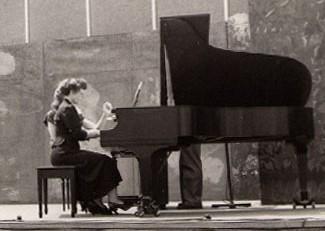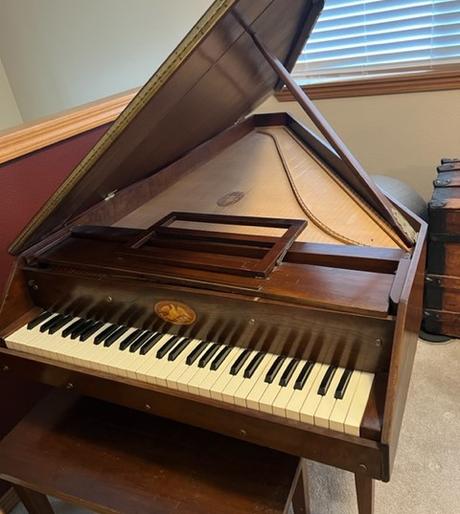Most likely it was because of him that a piano made its way into my mother’s childhood home where music and education were nurtured. As a young woman, she received her academic education from the University of Chicago whilst also attending The Chicago Musical College studying under Rudolph Ganz, a Swiss-born pianist, conductor and composer who introduced works by contemporary composers such as Bart贸k, Ravel, and Vincent d’Indy and who revived little-played older works in the Keyboard repertory.My mother once shared with me she had dreamt of being a concert pianist, but life had different plans for her. She fell in love, married whilst she was finishing her studies and gave her final university performance whilst pregnant.

Jean Eggleston, Chicago 1950 (Chicago Musical College)
When delivering my sister prematurely she was diagnosed with polio (in the maternity ward) resulting in a four month stay in hospital and five months in Warm Springs, Georgia at the polio rehabilitation center founded by Franklin D Roosevelt. She had lost the use of all four limbs and it is possible she was in an iron lung - she didn’t talk about it. She did recover aside from one leg, and after settling into life with a body that provided its challenges along with her new role as a wife and mother, she also began teaching piano in the home, sharing her love of music and inspiring others for decades.Whilst I was growing up, my mother’s students would come and go which included many of my friends. She didn’t think it was a good idea to teach her own children (wise woman) so my brother John and I would go toing and froing to our own piano teacher Mrs Crofts who was lovely, kind and supportive.Another keyboard instrument introduced to me as a child was the pipe organ. As my dad was a minister, our house was attached to the church and the organ music would resonate loudly throughout our house. When I was about 12, for a short period I took lessons from Walt Strony, the church organist, a young lad in his late teens. Our church was one of his first professional jobs. I think fondly of those lessons however my coordination doing the keyboard, stops and pedals failed me. Walt went on to perform on both theater and classical organs all over the world. He’s still performing and I continue to be in communication with him.As written in an earlier blog post, Weird (about my father dismantling a church pipe organ and reassembling it in our home, as one does), music and a keyboard instrument were also brought into our household by the patriarch of the family. Dad didn’t actually play the piano or organ but had a great appreciation of music and liked the challenge of building, rebuilding things and learning how something worked. Therefore he was keen to encourage my brother who at the age of 15, came up with a wild idea to build a Zuckermann harpsichord.The harpsichord dates back to as early as the 1400s. It went through several significant improvements, and by the 16th century in Europe it was very popular and by the 17th and 18th centuries (Baroque era) it reached its peak. JS Bach, Domenico Scarlatti and Fran莽ois Couperin are well known masters who composed specifically for this instrument. Two hundred years later, in the early 1960s, Wolfgang Joachim Zuckermann conjured up the idea of a harpsichord in kit form. In 1970, he had sold the business to David J Way who then began modifying it.I was about eight years old when the kit (most likely a Zuckermann original design) was delivered. I remember my dad building the body of it down in the basement in his man cave, my brother and father assembling it (gluing the pieces in the jacks (particularly liked the red felt bits), adding the strings, tuning it – yes, it was all very exciting and so interesting.
Zuckermann Kit Harpsichord, constructed by Herb and John Eggleston, circa 1970
Since its construction in 1970, our family harpsichord has had a useful life bringing joy to many. Early on, my mother’s students had the opportunity to experience the plucking of strings. This was such a different sound to the hammering of the piano. The harpsichord also has a smaller keyboard than the piano, 57 keys versus 88 keys. Thus Baroque music written specifically for the instrument and other adapted piano music was played.My brother played the harpsichord often, and once it went on an adventure with him to be played in a concert, Handel’s Messiah. After many years with our family (I enjoyed playing it too, Bach was a fav) it traveled on to John’s first apartment in Chicago, then was transported cross-country to San Francisco in 1980.When my brother tragically died ten years later, my sister and I drove the 800 miles to collect the instrument and 800 miles back to deliver it to my mother who by then was living in the Seattle area. She continued to share this remarkable instrument with her students. When she could no longer house it, the instrument lived in our friend Barbara’s music store where it was played by her students. In 2012 Barbara retired and sold the shop. The harpsichord then traveled to my sister, also in Seattle. In the summer of 2022 we decided as a family it was time for the harpsichord to have a new life.We sent information about the instrument to several music schools. That is how Dr Wendy Peng came on the scene. Wendy is a teacher who had studied piano performance, vocals and the harpsichord at university. She contacted us and we knew she was the perfect person to give life back into the instrument my dad and brother had so lovingly constructed. We gifted the harpsichord to her. Shortly thereafter she kindly sent us a recording of her playing it – beautiful.It has been nearly two years since the harpsichord left our family and I thought for this article I would contact Wendy to see how she bonded with the instrument and to find out more about her own personal journey with music.Wendy started playing the piano when she was four years old and continued playing because she loved the instrument. As her skills developed she discovered that piano playing was her true passion. When asked about playing the harpsichord she wrote [it] has a unique charm that I adore. Its crisp, bright sound and historical significance always fascinates me. I enjoy the challenge of mastering its technique and exploring the repertoire written specifically for it.I then ask what she thought made keyboard instruments so special and her reply [they] are special because they allow for incredible expression and creativity. They offer a vast range of tones and dynamics, enabling musicians to convey a wide range of emotions and moods through their playing.As for Wendy’s favorite harpsichord music, it is Canzona Francesa Quarta by Giovanni Maria Trabaci (ca 1575 – 31 December 1647). This piece is an example of the Baroque, a repertoire she particularly enjoys because it truly showcases the instrument’s capabilities and historical context. You can listen to this piece played by Marco Mencoboni: Canzona Francesca Quarta
She assures our family that she is
Maintain[ing] it with great care, ensuring that it continues to produce its beautiful
sound and serves as a cherished centrepiece in my musical endeavours.Knowing this fills me with so much joy.And on that note (no pun intended), I’ll finish with a Villanelle I wrote shortly after the harpsichord found its new home.The HarpsichordBy hand they built it underneath His wing
an instrument of joy, a time machine
to touch my heart, once plucked a broken string
dangling in front of me, remembering
my father, and my brother just fifteen,
by hand they built it underneath His wing
from treasured box, a kit with everything
making harmony, a family scene
to touch my heart, once plucked a broken string,
the cord cut short, from past to present cling
to makers lost and like from breast must wean.
By hand they built it underneath His wing.
I watch it still in dreams developing,
a photograph bathing that will come clean
to touch my heart, once plucked a broken string.
Be free object of beauty, play to sing
in worlds unknown I shall not intervene.
By hand they built it underneath His wing
to touch my heart, once plucked a broken string.
Thank you for reading,
Kate J
Sources
American Theatre Organ Society, 2024. Walter Strony. https://www.atos.org/artists/strony Accessed 3 May.
Peng, W., 2024. Email to Kate Eggleston-Wirtz. 30 April.
The Editors of Encyclopaedia Britannica, 2024. Rudolph Ganz American musician. https://www.britannica.com/biography/Rudolph-Ganz Accessed 3 May.
The Paris Workshop, 2024. A little history behind the Paris workshop. http://www.theparisworkshop.com/en/index-en.html?nav-en.html and http://www.theparisworkshop.com/en/history-en.html Accessed 3 May.University of Oxford, 2024. The Bate Collection, The Harpsichord. https://www.bate.ox.ac.uk/harpsichord Accessed 3 May.
Email ThisBlogThis!Share to TwitterShare to Facebook
